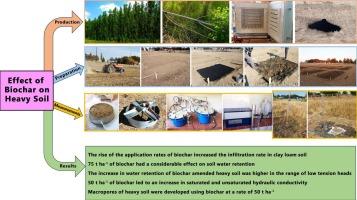Field study on the hydraulic behavior of heavy soil: Effects of biochar application rates
IF 8
1区 环境科学与生态学
Q1 ENVIRONMENTAL SCIENCES
引用次数: 0
Abstract
The amount of biochar applied in soil amendment significantly influences environmental impact, cost-efficiency, and soil improvement effectiveness. However, there is limited understanding of how varying biochar application rates affect the hydraulic performance of fine-textured soils under field conditions. A field-scale evaluation was conducted to determine how various rates of poplar wood waste biochar (0, 25, 50, and 75 t ha−1) influence the hydraulic characteristics of clay loam soil. Key soil physical and hydraulic properties were assessed, including mean weight diameter (MWD), bulk density (BD), average infiltration rate, soil moisture, flow dynamics in different pore classes, and both saturated and near-saturated hydraulic conductivity. The results showed that biochar application at 50 and 75 t ha−1 significantly increased MWD by 13.0 % and 17.7 %, field capacity by 3.7 % and 7.5 %, and permanent wilting point by 3.0 % and 6.1 %, respectively, while reducing BD by 14.5 % and 17.8 % compared to the control. A clear positive trend was observed between biochar application rate and average infiltration rate, with the highest rates (50 and 75 t ha−1) yielding the most substantial improvements in water infiltration. Applying biochar at 50 t ha−1 significantly improved saturated and near-saturated hydraulic conductivity in fine-textured soils by enhancing macropore flow, indicating beneficial changes to soil pore structure. This rate provided the best balance between improving soil hydraulic properties and resource efficiency, highlighting its potential as a sustainable practice to boost water infiltration and retention in water-limited agricultural systems.

重质土壤水力特性的田间研究:生物炭施用量的影响。
土壤改良剂中生物炭的用量对环境影响、成本效益和土壤改良效果有显著影响。然而,对于不同的生物炭施用量如何影响田间条件下细质土壤的水力性能,人们的理解有限。通过田间评价,确定了不同用量的杨木废生物炭(0、25、50和75 t hm -1)对粘壤土水力特性的影响。评估了土壤的主要物理和水力特性,包括平均重量直径(MWD)、容重(BD)、平均入渗速率、土壤水分、不同孔隙类型的流动动力学以及饱和和近饱和的水力导率。结果表明,与对照相比,施用50和75 t hm -1的生物炭显著提高了水田钻径13.0%和17.7%,田容量3.7%和7.5%,永久萎蔫点3.0%和6.1%,BD分别降低14.5%和17.8%。生物炭施用量与平均入渗速率呈明显的正相关,最高施用量(50和75 t hm -1)对水分入渗的改善最为显著。在50 t ha-1条件下施用生物炭,通过增强大孔流动,显著提高了细质土的饱和和近饱和导电性,表明土壤孔隙结构发生了有益的变化。这个速率提供了改善土壤水力特性和资源效率之间的最佳平衡,突出了它作为一种可持续实践的潜力,可以在水资源有限的农业系统中促进水的渗透和保持。
本文章由计算机程序翻译,如有差异,请以英文原文为准。
求助全文
约1分钟内获得全文
求助全文
来源期刊

Science of the Total Environment
环境科学-环境科学
CiteScore
17.60
自引率
10.20%
发文量
8726
审稿时长
2.4 months
期刊介绍:
The Science of the Total Environment is an international journal dedicated to scientific research on the environment and its interaction with humanity. It covers a wide range of disciplines and seeks to publish innovative, hypothesis-driven, and impactful research that explores the entire environment, including the atmosphere, lithosphere, hydrosphere, biosphere, and anthroposphere.
The journal's updated Aims & Scope emphasizes the importance of interdisciplinary environmental research with broad impact. Priority is given to studies that advance fundamental understanding and explore the interconnectedness of multiple environmental spheres. Field studies are preferred, while laboratory experiments must demonstrate significant methodological advancements or mechanistic insights with direct relevance to the environment.
 求助内容:
求助内容: 应助结果提醒方式:
应助结果提醒方式:


